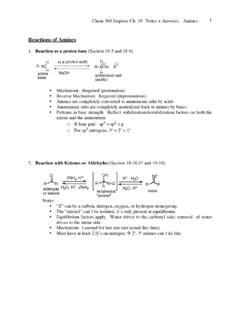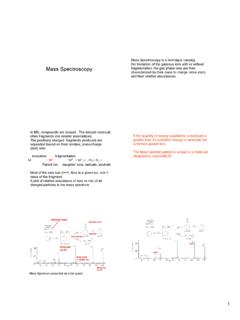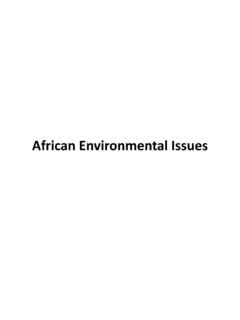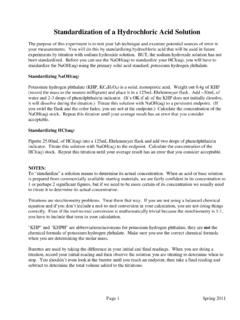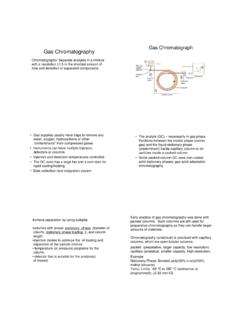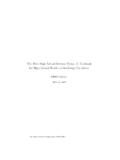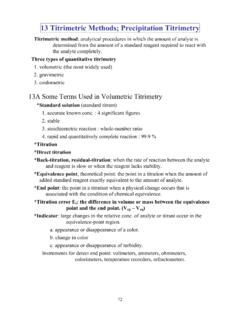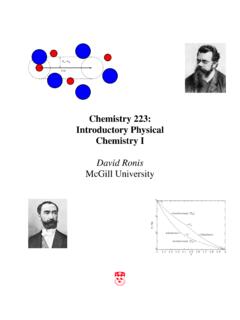Transcription of Chapter 4: Energy from Combustion The primary means of ...
1 Chapter 4: Energy from CombustionThe primary means of generating Energy for humanendeavors is the Combustion of :Coal-burned in power plantsGasoline-burned in automobilesNatural gas-heatingHeating oil , charcoal,wood,candles,.. Combustion (burning in air) releases thechemical energystored in the chemical bondsof the rate of use/consumption of fuels is fossil fuels supply is not fuels took millions of years to produce and products from the burning of fuels adversely affectthe soot, CO, Hg,SOx,NOx global warming, acid rain, poor air and water governing Energy transformation from limitation of converting all Energy in a fuels tousable content of different fuels (made up of differentchemical compounds).
2 Recent attempts at using Biofuels .Coal (70% in US) generates electricity in power of coal produces heat to boil water in a closed,high pressure turbine to create electricityThighTlowCoil of wire rotatingin a magnetic fuelsFossil FuelsPartial decompositionunder pressure and hightemperature(buried)Fossil fuelsCO2+ H2O+ Energy + sunlightCO2+ H2 OThe potential Energy stored in fossil fuels are the sun senergy captured, millions of years ago by the capacity to do movement against a force (w = f d).Definitions:Heatis Energy that flows from a hotter to a colder the direction of heat a consequence of motion at the molecular level;temperatureis a measure of the average speed of Law of ThermodynamicsPotential/Kinetic energyFirst Law: The Energy of the universe is constant, , Energy can neither be created nor destroyed;but it can be converted fromone form to Energy (PE)is Energy due to positionand/or composition of with higher PE are better Energy (KE)is Energy due to movement ofmatter.
3 = Energy ( chemical bonds-fuel)Kinetic Energy (steam)Mechanical energyTurbineElectrical energyBurner-heatgas turbinegeneratorTaking random, thermal Energy andtransforming it into ordered workgoes against theSecond Law of Second Law of ThermodynamicsTheentropyof the universe plants are inevitably First Law of ThermodynamicsEnergy is neither created nor destroyed,but may be transformed from one formto Plant electric power plant can completely convert one typeof Energy into another. Efficiency is always <100%Some of the Energy is transferred into unusable higher the temperature of the steam, the moreefficient the power plant but other issues such as abilityto withstand high temperatures and pressures 100fuelfromheatproducedenergyelectricale fficiency%Net The Second Law of ThermodynamicsTheentropyof the universe is heatdissipates to the environment.
4 Themolecules in the environment picks up the heat, theirkinetic Energy molecules move faster and disperses the energygained and that Energy can never be Energy raises the degree of random movementof molecules termed Entropy. Overall the entropyof the universe heatThejoule(J): 1 J is the amount of Energy required toraise a 1-kg object 10 cm against the force of (cal): 1 cal is the amount of heat required toraise the temperature of 1 g of water by calorie = J1 kcal = 1000 cal =1 Cal (1 dietary cal)So that 450 Cal doughnut is really 450,000 calories!Raw Materials for Energy : Coal Coal is a complexmixtureof substances. Better Energy source (low %O,high %C) andexists in many grades.
5 92% coal in US power industry Although not a single compound, coal can beapproximated by the chemical formulaC135H96O9NS. SomeS, Si, Na, Ca, Al, Ni, Cu,Zn,As,Pb, all coal is created equal!Anthracite-Nearly of underground, dangerous and expensive;respiratory water flooding of abandoned mines in contactwith S rich coal generates acids. Acids dissolves Feand Al,-fish habitat and drinking water closer to surface mountaintop mining massive rubble overburden dumped into rivers andvalleys and eco systems and drinking water of Coal:4. Dirty fuel . Soot buildings and lungs;NOx, gets concentrated inflyash PM in ash storage problems!
6 !5. CO2more per kJ vs. petroleum or natural global emissions of CO2. Clean Coal A collection of methods to increase efficiency of coal firedpower plants while decreasing harmful plants. Coal washing, to remove S and minerals before Combustion . Gasification. Coal + H2O CO + H2(water gas; burns atlower T, noNOx) Wet scrubbing. Remove SO2(with limestone + water)Does not address emission of greenhouse gases.(Carbon capture and storage).Coal, to be made more usable as a fuel needs a changeof phase to gas or liquid (s) + H2O(g) CO(g) + H2(g)(water gas, both components are fuels)Catalyst (Fe/Co)nCO(g) + (2n+1) H2(g) CnH2n+2(g, l) + nH2O(g)n=1, methane, n=2,3 (g)n= 5-8, gasolinecomponents(l)Liquefaction/Gasifi cationof coal: Fisher-TropschProcessIn the end coal still produces CO2!
7 Also the production and useproduces more CO2than of Energy Consumption by Source 1800 20081 EJ = use around the world:Green= 1999 Gold= 2009 The unit is million metric tons oil equivalent, theapproximate Energy released in burning a million metrictons of mixture ofthousands must berefined before vs. 30kJ/g (highgrade Tower:Only a fractionTable ; C-C and C-H bonds do we use each barrel (42 gal) of petroleum?This galincludesnonrenewablefeedstocksfor allplastics,pharmaceuticals,fabrics and 87% of each barrel is used for transportation Oil (Recoverable) Scenarios:?Assumption 2% increase per year of Gas:Raw: Methane, 2-6% ethane, small hydrocarbons,water vapor, CO2H2S and in homes, electricity production, burning ( S removed at refinery, unburnedmaterial low.))
8 No CO2and lesser Energy per unit involving energyThe absolute (potential) Energy of any reactants andproducts (fuel or oxidant) cannot be the difference in (potential) Energy of reactants andproducts can be Energy from a reaction is the difference in potentialenergy between product and reactants, after potential Energy of reactants and products are storedin their chemical reactions of importance are Combustion of Combustion -definition and measurementDefinition: The heat given off when a specified amount(1 mole) of a substance (reactant) burns in oxygen (g) + 2 O2(g) CO2(g) + 2H2O (l) + calorimeters can be used to determine the heat calorimetersIf you test a reactionthat releases heat, thetemperature of thewater will (g)C) T(C)(kJ/CgramperenergyC) T(riseeTemperaturC)(kJ/Crcalorimeteofcap acityHeatm(g)fuelmassoocaloocal (g) + 2 O2(g) CO2(g) + 2H2O (l) +ENERGYH ydrocarbon fuels like methane (CH4) burn in thepresence of oxygen to produce carbon dioxide andwater.
9 This process ofcombustion releases is releasedduring the course of a chemicalreaction, it is said to be Combustion ofofmethane gas releases is the equivalent of kJ/mol kJ/g ( + 4 )g/mol = products are lower in Energy than the reaction: Eis a negative value. E =CH4(g) + 2 O2(g) CO2(g) + 2H2O (l) + EEnergy all fuels are not created will have products higher inenergy, ( Ewill be positive) than the reactants; there willstill be a required activation Energy . E = 2800kJ/mole of Changes at the Molecular LevelThe Energy changes are due to the rearrangementof the atoms during reaction. The energiesinvolved in breaking and forming of bonds dictatesif a reaction will be endothermic or the amount of Energy that must beabsorbed to break a chemical demands/requires Energy !
10 Formingbonds releases Energy ! (for gas phase reactions )(Average values)Breakingbonds demands/requires Energy !overall it is , BondBreaking EnergiesFormingbonds releases Energy !overall it is , Bond FormingEnergiesNet Energy change for the reaction=BondBreaking Energies +Bond FormingEnergiesBonds breaking2 H H + O=OBonds forming4 O H (2 H O H)Consider:2 H2+ O22 H2O2 (+436) + (+498) + 4 ( 467) kJ =-498 :2 H2+ O22 H2 OBonds breaking2 H H + O=OBonds forming4 O H(2 H O H)GasolineOnly a fraction of distilled crude oil is gasoline jet fuel anddiesel. Higher boiling fractions are in less Cracking:Conversion of high ( ) boiling compounds to low( ) boiling involves heating to 400 +2CH3CH3CH3CH3CH3CH3CH3CH3+2ororororcata lystCatalytic Cracking:lower temperatures employed, thusless Energy used.

